[ad_1]
The autumn season is, by far, essentially the most rewarding time of yr for any panorama photographer. Nature’s transformation rewards us with distinctive colour pallets that exist solely throughout the season of fallen leaves.

The autumn season is comparatively lengthy and, relying on the yr, can final wherever between 50 and 90 days. What really makes this time of yr distinctive is that nature’s transformation is in fixed flux. The temperature, wind, and humidity have an effect on the velocity of the transformation and we, as photographers, have to be able to seize completely different phases of the season because it adjustments.
For instance, a chilly evening with destructive temperatures throughout the peak of the autumn season will speed up the altering colours of the foliage. The panorama will look completely different the next day.
One other instance is the frequent fall storms which are infamous for blowing the leaves off the bushes, fully altering the look of a scene in simply hours.
What this implies is you can’t afford to attend for good mild or favorable climate. For those who discover an attention-grabbing composition with thrilling colours, you need to seize the chance immediately earlier than it vanishes.
Autumn images shouldn’t be very completely different from conventional panorama images, however it does have one fundamental distinguisher—the distinctive colours of the leaves. The aim of fall images is to find and naturally incorporate the autumn foliage into panorama compositions.
Fall Pictures Concepts and Ideas
At present, I’ll share my favourite concepts and suggestions with you on methods to method foliage images.
01. Ongoing (Perpetual) Scouting
My greatest scouting tip for fall images is to scout places all yr lengthy.
For instance, chances are you’ll come throughout an attention-grabbing composition of a water reflection solely to comprehend that the inexperienced leaves within the reflection aren’t as interesting throughout the summer season months. You would possibly contemplate returning to the identical location within the fall to see if the yellow and purple foliage make the composition extra enticing.
Seize the scene along with your cell phone and reserve it to the Fall Foliage Concepts folder in Evernote (that is what I do). Another choice is to pin the picture to a customized Google Map (My Maps). For those who do that all year long, when autumn arrives you’ll have loads of concepts for foliage photographs.
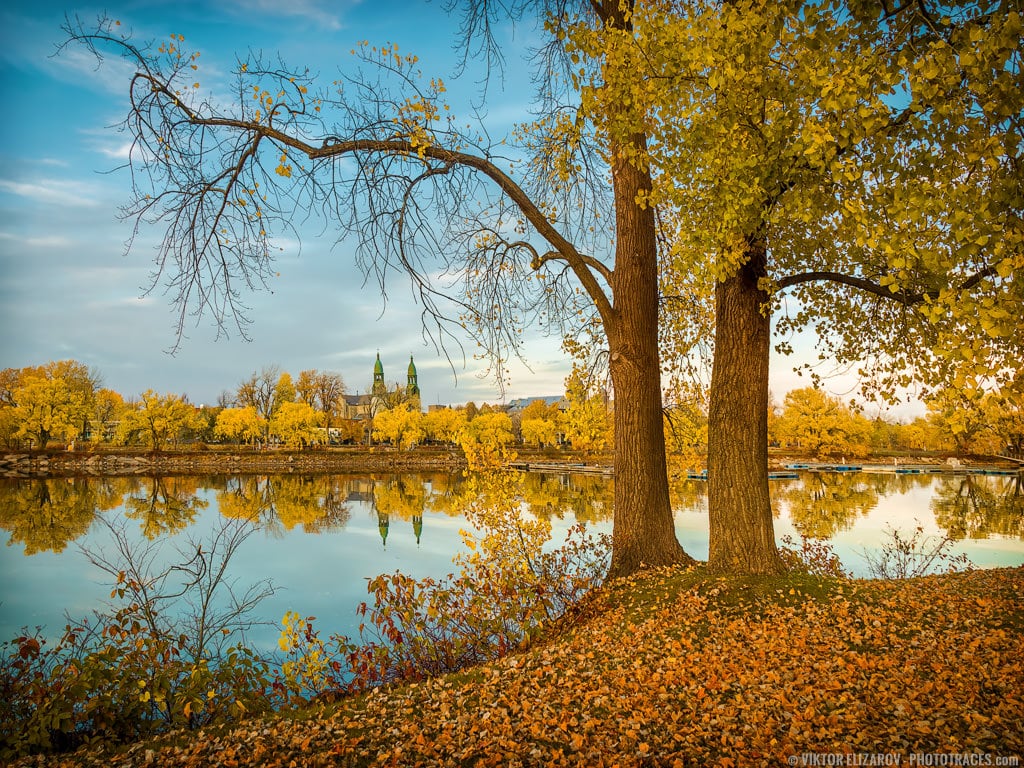

02. Use On-line Instruments to Analysis Your Particular Location
Each fall season is completely different. Relying on the climate throughout the spring and summer season, colour adjustments can begin earlier or a lot later. The transformation can final a full three months or disappear after a short six weeks. Freezing situations can prematurely finish the colourful fall foliage, which is usually what occurs in Jap Canada the place snowfall in early November shouldn’t be unusual.
I additionally keep in mind that we didn’t have any thrilling autumn foliage round Montreal for 3 years in a row. My guess is that extraordinarily dry summers affected the colours.
One other vital issue that impacts the timing of the autumn colour transformation is altitude. The upper the elevation, the earlier the transformation begins. Even a small elevation of 500m can yield a change in timing by weeks.
The excellent news is that we will analysis a selected location earlier than we depart for our colour searching expedition.
For instance, within the province of Quebec the place I stay, I take advantage of an interactive map referred to as The Enchantment of Colours.
Listed below are a couple of different on-line sources I’ve found over time:
Merely do some analysis on Google to search out foliage studies on your particular location.
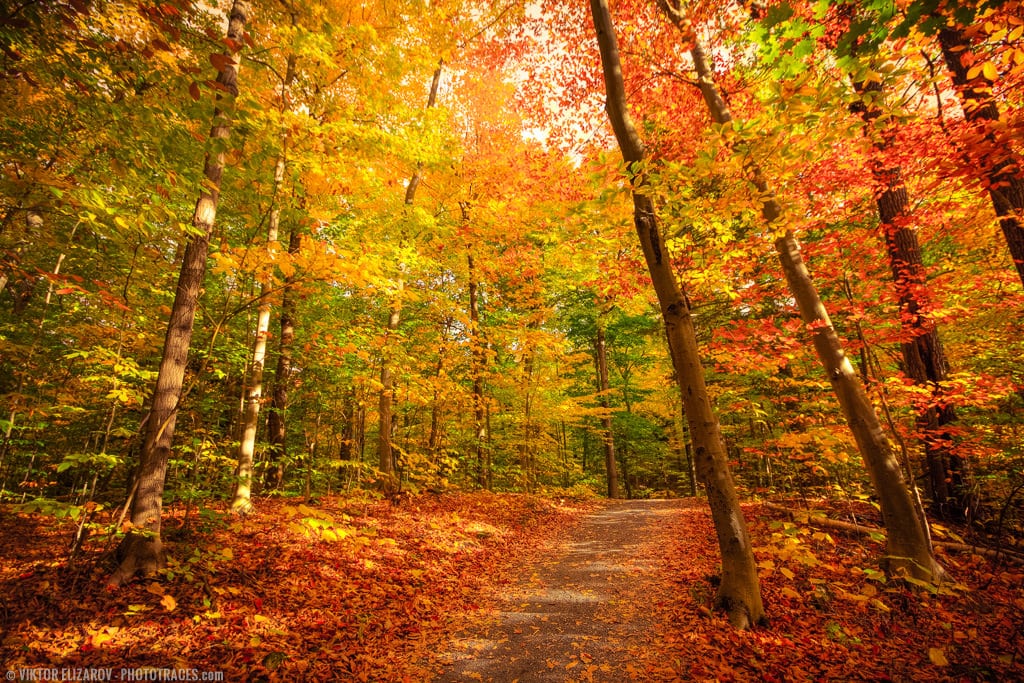

03. Do Not Worry Gloomy Overcast Days
From a images standpoint, I discover that the autumn season is extra forgiving in regard to unfavorable mild. Most photographers favor to remain residence throughout overcast days when gray clouds function a large diffuser canceling the distinction and desaturating the colours.
However, throughout autumn, not even a boring overcast sky can remove the colourful foliage colours. The colours are current in each composition and, even when their depth is lowered, it’s straightforward to deliver them again to life throughout post-processing.
Overcast days throughout the autumn season give us the chance to {photograph} all the day with out worrying concerning the solar’s place.
I like overcast autumn days when the standard and depth of sunshine doesn’t change all through all the day. It creates an nearly studio-like managed atmosphere for panorama images.
The sunshine is fixed, the shadows are smooth, and the muted colours mix properly collectively to create a painting-like scene.
The one problem throughout overcast days is to reduce and even remove the boring white or gray sky from the composition. My favourite trick for coping with a boring sky is to shoot from contained in the forest the place the bushes protect the sky fully.


4. Discover Water. Make Mirror Reflections
The mirror water reflection is, by far, my favourite autumn images method. When you will have an abundance and a wide range of colours that create pleasure and drama in your composition, you may double it by introducing reflections.
The principle problem when creating mirror reflections is to have quiet windless climate. Quiet days are uncommon the place I stay. My favourite tip for locating good mirror reflections is visiting small lakes surrounded by the forest. In locations like this, you’ll find quiet corners even on a windy day.


5. Create Autumn Abstracts
I really admire impressionist work, particularly the work of Claude Monet. Yearly, autumn colours encourage me to experiment with extra summary ideas by creating dream-like compositions.
My favourite method for creating autumn abstracts is to {photograph} water reflections and make them the point of interest of the composition. In such instances, I don’t want completely nonetheless water. I need slowly working water, which helps me produce the blurry, dreamlike impact that you simply usually discover in summary or impressionist work.


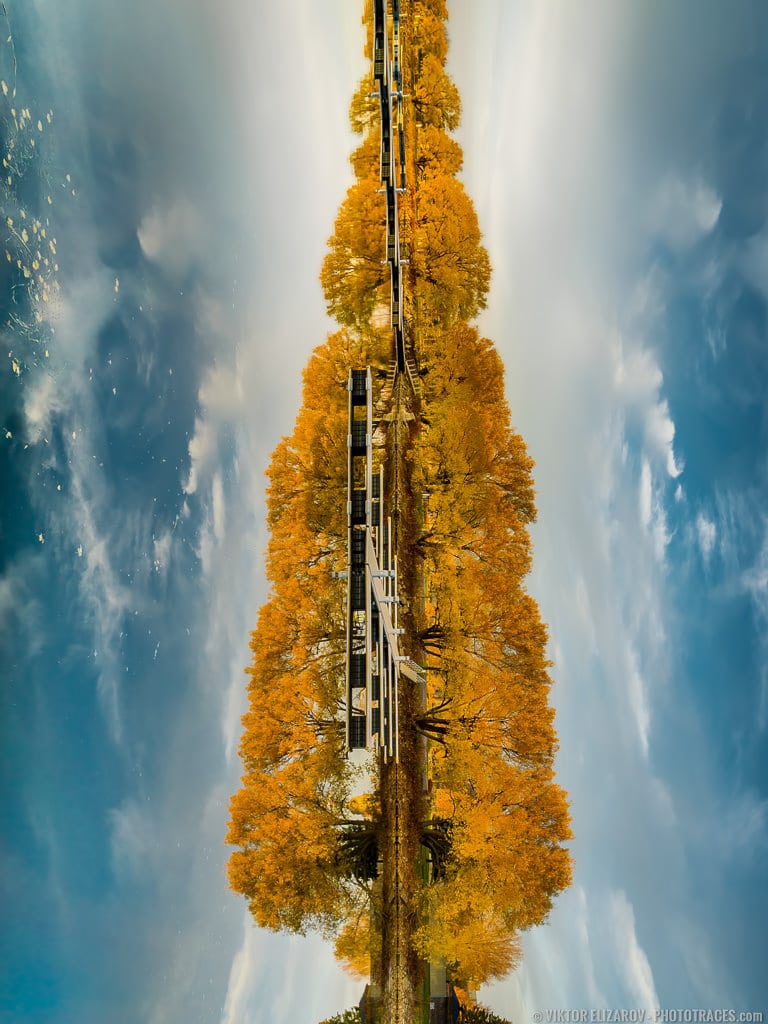

6. Take Benefit of Sunrises
Mild is completely different all through the day due to the place of the solar. At noon, the daylight falls nearly vertically and the diffusing impact of the environment is minimal. This leads to sharply-lit excessive distinction photographs that don’t look as pleasing to the attention.
Within the morning and on the finish of the day, nonetheless, the solar is nearer to the horizon and it takes mild longer to enter by way of the environment. That’s why photographs taken at sundown have softer shadows and highlights.
One other attribute of morning and night mild is its heat. When mild travels by way of the environment, its particles scatter the blue spectrum of sunshine, which makes the sunshine hotter. The longer the sunshine travels by way of the environment, the hotter the sunshine turns into. For that purpose, 30 to 60 minutes after dawn and 30 to 60 minutes earlier than sundown are thought of to be essentially the most favorable occasions for panorama images. This is called the Golden Hour.
For my panorama images, I favor sunsets over sunrises as a result of they usually produce extra dramatic pictures. However, for autumn images, sunrises give us extra alternatives to create attention-grabbing and clear pictures. Chilly autumn nights produce a lot cleaner air by lowering haziness. One other good thing about capturing at dawn is the prospect to come across the morning mist, which might improve any composition.


7. Use Backlighting Method
Backlighting might be the preferred method when capturing autumn foliage.
Right here is the way it works. If you place the foliage between the digicam and the solar, the foliage is illuminated from behind to create a translucent and radiant impact of glowing mild across the leaves. On the similar time, the foliage diffuses the sunshine and makes it a lot softer than direct daylight.
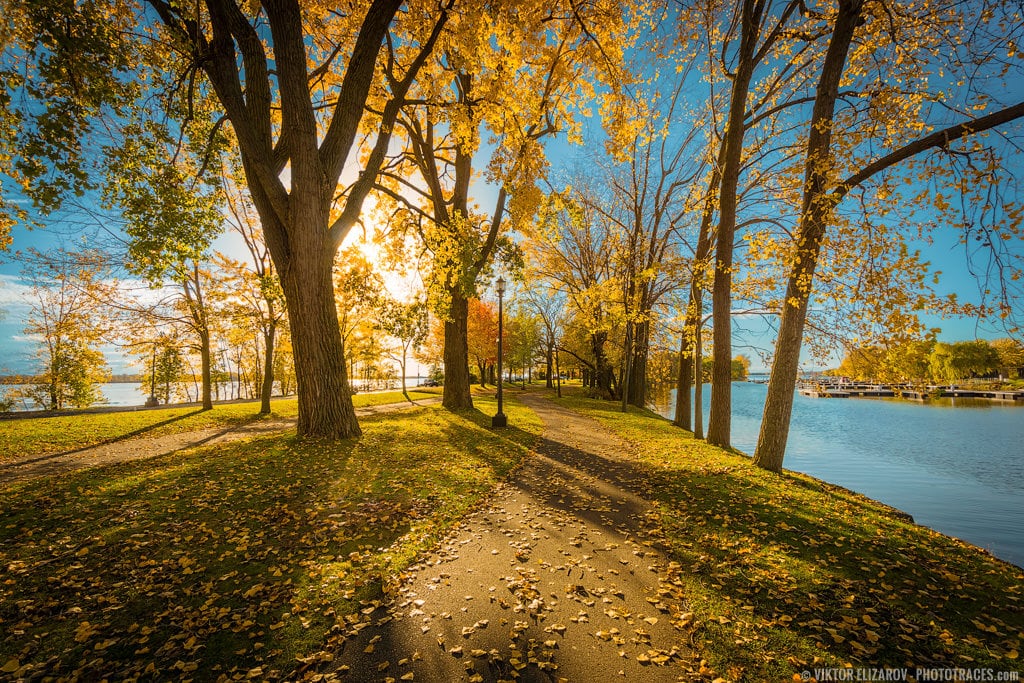

8. Shoot Instantly Into the Solar for a Extra Dramatic Impact
So as to add much more drama to an already dynamic scene, attempt capturing instantly into the unobstructed solar. This may be technically difficult and require the usage of publicity bracketing together with the HDR method, however it’s extremely rewarding for the reason that pictures can produce a singular and climactic composition.


9. Use Polarized Filter
I’m not an enormous fan of utilizing filters in my images. Through the years, I steadily eradicated most of them from my routine as a result of it’s simpler for me to recreate the impact of the filters throughout modifying. However, there’s one exception—I nonetheless use a polarized filter.
There’s a widespread false impression that the primary operate of polarized filters is to reinforce the colours of the scene particularly the blue colours of the sky. However, this isn’t true. Although the polarized filter impacts the colours in our photographs, you may obtain even higher outcomes with higher precision in post-processing.
The principle operate of the polarized filter is to scale back reflections and glare. I discover it’s the most helpful when capturing autumn foliage after the rain. The water drops on the leaves can produce an undesirable glare by reflecting the daylight. The polarized filter can drastically cut back this glare.
Another excuse to make use of polarized filters is that its antireflection impact can’t be recreated in post-processing.


10. Embrace Unhealthy Climate
When analyzing my previous photographs, I spotted that unhealthy climate equals higher and extra dramatic photographs.
That is the way it usually works. You stroll in stormy climate and all you see is the darkish, moody sky. However, there’s all of a sudden a small opening within the clouds and the beam of daylight illuminates a part of the scene. The colours and distinction create unbelievable drama. The second lasts solely minutes, simply lengthy sufficient so that you can take your greatest picture of the yr.
The issue with a majority of these pictures is that you simply can’t plan them upfront. All you are able to do is present up and be prepared for something. The extra time you present up, the upper the prospect that you’ll seize one thing superb.
In autumn, you will have much more possibilities to seize pure, dramatic scenes as a result of, as autumn progresses, the climate will get worse and worse.
The mixture of a weather-sealed digicam and weather-sealed lens is an amazing assist on the subject of coping with unhealthy climate. Since I upgraded my digicam to a weather-sealed model, I discover myself an increasing number of keen to exit and shoot in any climate. I’ve no extra excuses to remain residence throughout the autumn rain.
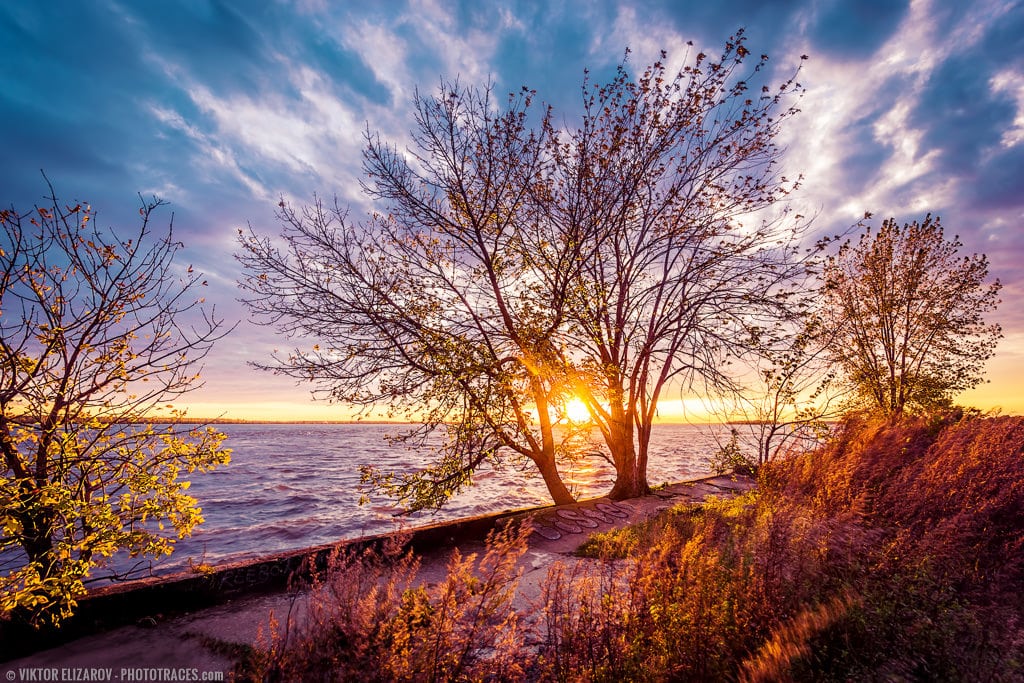

11. Shoot RAW
This tip shouldn’t be unique to autumn images. I all the time suggest capturing in RAW format no matter what kind of images you pursue. However, for autumn foliage images, capturing in RAW is much more related. RAW format provides us extra latitude to govern the colours of photographs with even higher precision. When utilizing RAW editors like Lightroom, you may obtain your inventive imaginative and prescient even simpler when concentrating on particular person colours in your RAW picture.


12. Use Presets
Since we take and edit fall pictures just for a brief time frame, it is sensible to create a devoted preset assortment. The gathering you may reuse yr after yr. The thought is you should not have to start out modifying from scratch each September.
One other various is to seize my Fall Colours Assortment and create your personal presets utilizing Fall Colours as a basis.
Fall Pictures Concepts and Ideas: Last Ideas
The autumn season provides a large number of alternatives for capturing beautiful foliage photographs. By following these 12 concepts and suggestions, you may improve your images expertise and seize the great thing about autumn in all its glory.
[ad_2]
